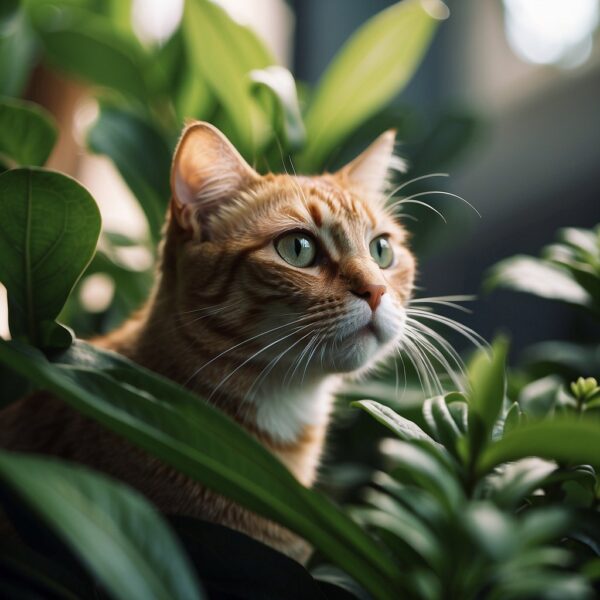
ZZ Plant Toxicity: the Risk to Cats
The Zamioculcas zamiifolia, commonly known as the ZZ plant, is a popular ornamental houseplant appreciated for its waxy, dark green leaves and its ability to thrive under low-light conditions. Is the ZZ plant toxic to cats? While aesthetically pleasing and easy to care for, it is also known to contain calcium oxalate crystals, which are considered to be toxic to both humans and animals when ingested. Cat parents, in particular, may express concern over the potential risks posed to their feline companions, as cats are known to nibble on houseplants.
When cats ingest parts of the ZZ plant, the calcium oxalate crystals can cause irritation to the mouth, gastrointestinal tract, and, in severe cases, lead to vomiting or diarrhea. Therefore, it is crucial for cat parents to understand the toxicity levels of the ZZ plant and to take measures to keep these plants out of reach from their cats. While the plant is not usually lethal, it can cause enough discomfort to warrant caution. Awareness and understanding of the toxicity of the ZZ plant can help cat parents prevent any potential harm to their cats and ensure a safe and harmonious living environment for both plant and cat.
Key Takeaways
- ZZ plants contain calcium oxalate crystals that can be toxic when ingested.
- Ingestion of the plant by cats can lead to mouth and stomach irritation.
- Keeping ZZ plants out of cats’ reach is important to ensure their safety.
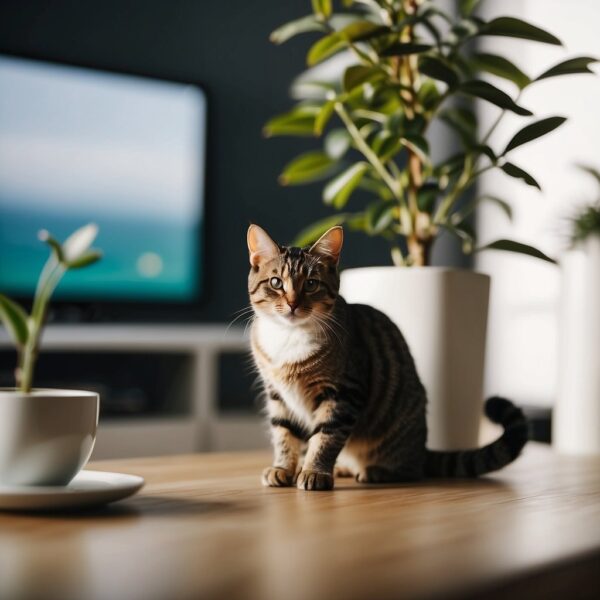
Overview of ZZ Plant Toxicity
The ZZ plant, scientific name Zamioculcas zamiifolia, contains substances known to be mildly toxic to cats when ingested. Primarily, these plants contain calcium oxalate crystals, which can cause irritation and discomfort when they come into contact with a cat’s oral cavity or skin.
When a cat chews or ingests parts of a ZZ plant, the following symptoms may occur:
- Oral irritation: Includes burning of the mouth and lips, excessive drooling, and difficulty swallowing.
- Gastrointestinal upset: Manifests as vomiting or diarrhea attributable to the irritation of the stomach and intestines.
To ensure feline safety, it is recommended that cat parents:
- Place ZZ plants out of reach of cats.
- Monitor for any signs of nibbling on houseplants.
- Be aware of the symptoms and seek veterinary care if they occur.
Although the plant’s toxicity is generally mild and serious complications are rare, proactive measures should be taken to prevent cats from accessing the plant. Contact with the eyes can result in additional irritation, hence rinsing with water is advised should such contact occur.
The aesthetics and low-maintenance nature of the ZZ plant make it a popular choice for households, but when it comes to homes with cats, caution is warranted. Cat parents need to balance the desire for these houseplants with the well-being of their pets.
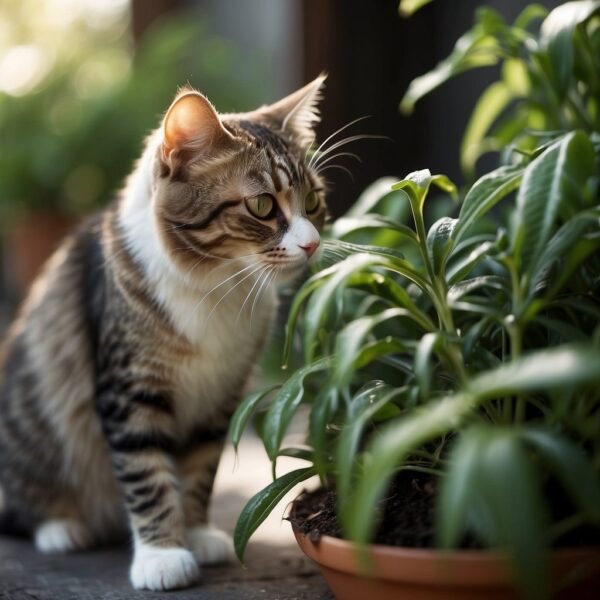
Toxicity to Cats
The Zamioculcas zamiifolia, commonly known as the ZZ Plant, contains calcium oxalate crystals which are toxic to cats when ingested.
Symptoms of Poisoning
When a cat ingests parts of the ZZ plant, symptoms can include:
- An upset stomach
- Vomiting
- Diarrhea
Symptoms are generally short-lived but depend on the quantity consumed.
Common Toxic Compounds
The primary toxic compound in ZZ plants responsible for toxicity to cats is:
- Calcium oxalate crystals: These can cause irritation and discomfort upon ingestion.
Emergency Response to Ingestion
In the event a cat ingests ZZ plant materials:
- Remove any plant remnants from the cat’s mouth.
- Observe the cat for any signs of distress.
- Contact a veterinarian immediately for professional advice.
Preventive Measures
It is imperative for cat parents to ensure the safety of their cats by taking proactive steps to prevent ZZ plant exposure.
Safe Placement of ZZ Plants
- Place the ZZ plants out of reach: It is advisable to position ZZ plants on high shelves or in rooms that are inaccessible to cats.
- Utilize plant stands: A tall plant stand can deter cats from reaching the plants due to the height and instability for climbing.
Alternative Non-Toxic Plants
- Offer substitutes: Consider decorating the home with cat-safe plants such as spider plant (Chlorophytum comosum) or Boston fern (Nephrolepis exaltata).
- Label clearly: Maintain a clear distinction between toxic and non-toxic plants by using visible labels as reminders.
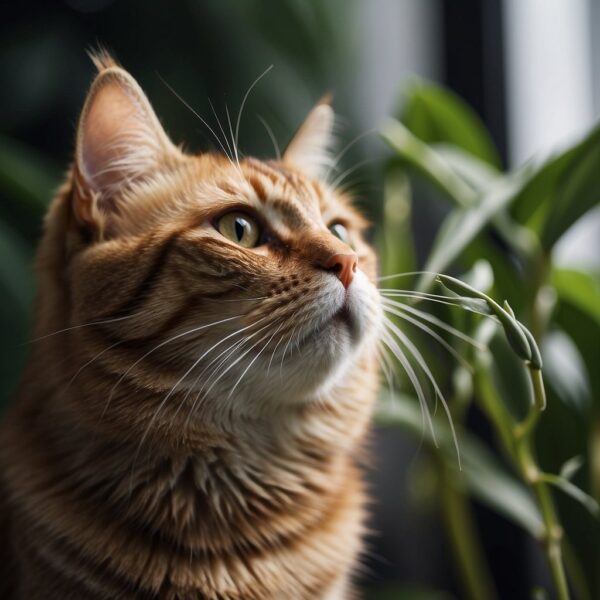
Understanding ZZ Plant Toxicity Levels
ZZ plants (Zamioculcas zamiifolia) are known to contain calcium oxalate crystals, which are the primary cause of their toxicity. These needle-like crystals can cause irritation if ingested or if they come into contact with the skin.
For Cats
Cats are particularly sensitive to ZZ plants due to their curious nature and propensity to chew on leaves. The ingestion of plant material can lead to:
- Vomiting
- Diarrhea
- Oral irritation
Toxicity Indicators
The presence of calcium oxalate crystals in ZZ plants categorizes them as mildly toxic. Direct ingestion of the plant’s leaves or sap can result in:
- Pain and swelling of the mouth
- Excessive drooling
- Difficulty swallowing
For a cat, even small amounts can be distressing, and veterinary attention may be necessary if symptoms persist.
Precautions
Guardians should:
- Keep ZZ plants out of reach
- Monitor their cats for any interaction with the plant
- Consult a veterinarian promptly if ingestion occurs
It’s crucial for cat parents to understand the level of toxicity. ZZ plants are not lethal, but their effects can be very uncomfortable for a cat, potentially requiring medical attention.
Caring for a ZZ Plant With Cats in the House
When maintaining a ZZ plant (Zamioculcas zamiifolia) in a home shared with cats, one must exercise particular caution due to the plant’s toxic properties.
Preventive Measures:
- Placement: Keep the ZZ plant out of reach. Preferably, place it on high shelves or in rooms that cats cannot access.
- Barriers: Consider physical barriers such as pet gates or plant cages to limit feline access.
Immediate Actions Upon Ingestion:
- Identification: Watch for signs of discomfort such as drooling, pawing at the mouth, or vomiting.
- Veterinary Assistance: If these symptoms occur, contact a veterinarian promptly.
Routine Precautions:
- Regular Checks: Inspect the plant regularly for signs of nibbling.
- Foliage Maintenance: Remove any fallen leaves promptly to prevent accidental ingestion.
Alternative Measures:
- Cat Grass: Provide cat grass or other safe plants for cats to chew on, which may deter interest in the ZZ plant.
- Positive Reinforcement: Utilize positive reinforcement to train cats to avoid the plant.
By adhering to these guidelines, one can maintain a ZZ plant in the house with minimal risk to feline companions.
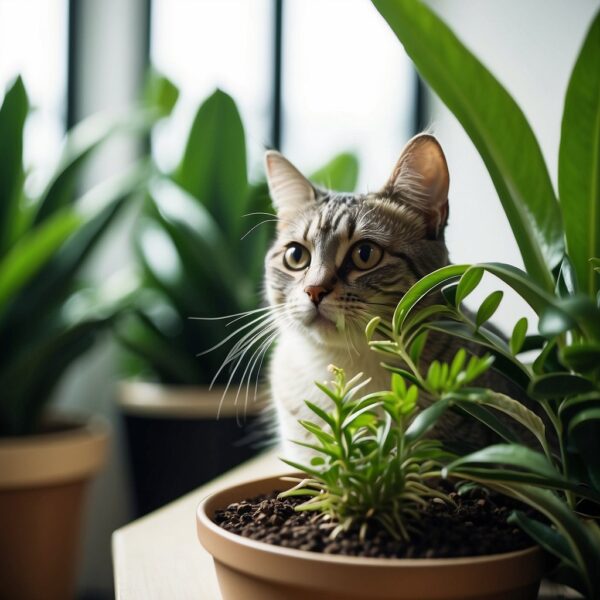
Professional Advice and Resources
When considering the potential toxicity of ZZ plants to cats, cat parents should seek professional advice and credible resources to ensure accurate information. Veterinarians and professional plant experts can provide guidance based on scientific evidence and clinical experience.
Veterinary Consultation: Seeking advice from a veterinarian is paramount when it comes to assessing risks to feline health. A vet can describe specific symptoms to watch for and emergency care protocols in case of plant ingestion.
Professional Organizations:
- ASPCA: The American Society for the Prevention of Cruelty to Animals offers a comprehensive database of plants with detailed toxicity levels to pets.
- Pet Poison Helpline: A resource accessible 24/7 for immediate professional guidance on potential pet poisoning.
Relevant Literature and Studies:
- Peer-reviewed journals on veterinary medicine.
- Research on household plant toxicity.
Preventative Measures:
- Place plants out of cats’ reach.
- Educate family members on the risks.
Contact Information to Keep Handy:
- Local veterinarian contact.
- Nearby animal hospital.
- Poison control hotline.
Ensure any advice or information is up-to-date and accurate, as outdated or inaccurate sources can mislead cat parents on the risks associated with ZZ plants and feline toxicity.
Frequently Asked Questions
Understanding the potential hazards of ZZ plants is crucial for cat parents to ensure the safety and well-being of their feline companions.
Can a ZZ plant cause harm to a cat if ingested?
Yes, if a cat ingests parts of a ZZ plant, it can experience toxicity because the plant contains calcium oxalate crystals which can be irritating to the mouth and stomach.
What symptoms should I look for if I suspect my cat has chewed on a ZZ plant?
Symptoms of ZZ plant ingestion may include drooling, vomiting, lack of appetite, and pawing at the mouth due to irritation. If these or other signs of distress are observed, it is important to consult a veterinarian.
What immediate steps should be taken if a cat has ingested part of a ZZ plant?
If ingestion is suspected, remove any plant material from the cat’s mouth and provide fresh water. Contact a veterinarian promptly for advice on the next steps, which might include monitoring or medical intervention.
Are there any particular parts of the ZZ plant that are more toxic to cats?
All parts of the ZZ plant contain calcium oxalate crystals, making them equally toxic. Therefore, any ingestion of plant parts can potentially cause the same symptoms.
How can I prevent my cat from coming into contact with my ZZ plant?
Keeping the ZZ plant out of reach by placing it on high shelves, using protective barriers, or employing deterrents can prevent contact. Additionally, cat parents can choose to not have ZZ plants where cats have access.
What are some of the most toxic plants to cats that I should avoid having at home?
Some plants that are highly toxic to cats include lilies, sago palms, oleander, and azaleas. It is advisable to avoid having these plants in environments where cats live.